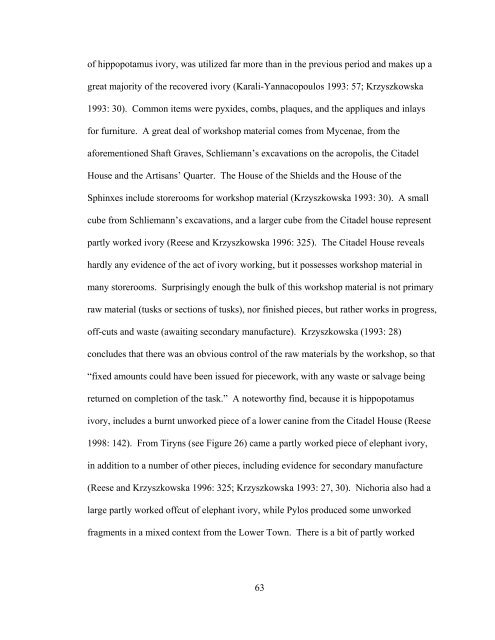Tracing the Source of the Elephant And Hippopotamus Ivory from ...
Tracing the Source of the Elephant And Hippopotamus Ivory from ...
Tracing the Source of the Elephant And Hippopotamus Ivory from ...
You also want an ePaper? Increase the reach of your titles
YUMPU automatically turns print PDFs into web optimized ePapers that Google loves.
<strong>of</strong> hippopotamus ivory, was utilized far more than in <strong>the</strong> previous period and makes up a<br />
great majority <strong>of</strong> <strong>the</strong> recovered ivory (Karali-Yannacopoulos 1993: 57; Krzyszkowska<br />
1993: 30). Common items were pyxides, combs, plaques, and <strong>the</strong> appliques and inlays<br />
for furniture. A great deal <strong>of</strong> workshop material comes <strong>from</strong> Mycenae, <strong>from</strong> <strong>the</strong><br />
aforementioned Shaft Graves, Schliemann’s excavations on <strong>the</strong> acropolis, <strong>the</strong> Citadel<br />
House and <strong>the</strong> Artisans’ Quarter. The House <strong>of</strong> <strong>the</strong> Shields and <strong>the</strong> House <strong>of</strong> <strong>the</strong><br />
Sphinxes include storerooms for workshop material (Krzyszkowska 1993: 30). A small<br />
cube <strong>from</strong> Schliemann’s excavations, and a larger cube <strong>from</strong> <strong>the</strong> Citadel house represent<br />
partly worked ivory (Reese and Krzyszkowska 1996: 325). The Citadel House reveals<br />
hardly any evidence <strong>of</strong> <strong>the</strong> act <strong>of</strong> ivory working, but it possesses workshop material in<br />
many storerooms. Surprisingly enough <strong>the</strong> bulk <strong>of</strong> this workshop material is not primary<br />
raw material (tusks or sections <strong>of</strong> tusks), nor finished pieces, but ra<strong>the</strong>r works in progress,<br />
<strong>of</strong>f-cuts and waste (awaiting secondary manufacture). Krzyszkowska (1993: 28)<br />
concludes that <strong>the</strong>re was an obvious control <strong>of</strong> <strong>the</strong> raw materials by <strong>the</strong> workshop, so that<br />
“fixed amounts could have been issued for piecework, with any waste or salvage being<br />
returned on completion <strong>of</strong> <strong>the</strong> task.” A noteworthy find, because it is hippopotamus<br />
ivory, includes a burnt unworked piece <strong>of</strong> a lower canine <strong>from</strong> <strong>the</strong> Citadel House (Reese<br />
1998: 142). From Tiryns (see Figure 26) came a partly worked piece <strong>of</strong> elephant ivory,<br />
in addition to a number <strong>of</strong> o<strong>the</strong>r pieces, including evidence for secondary manufacture<br />
(Reese and Krzyszkowska 1996: 325; Krzyszkowska 1993: 27, 30). Nichoria also had a<br />
large partly worked <strong>of</strong>fcut <strong>of</strong> elephant ivory, while Pylos produced some unworked<br />
fragments in a mixed context <strong>from</strong> <strong>the</strong> Lower Town. There is a bit <strong>of</strong> partly worked<br />
63

















